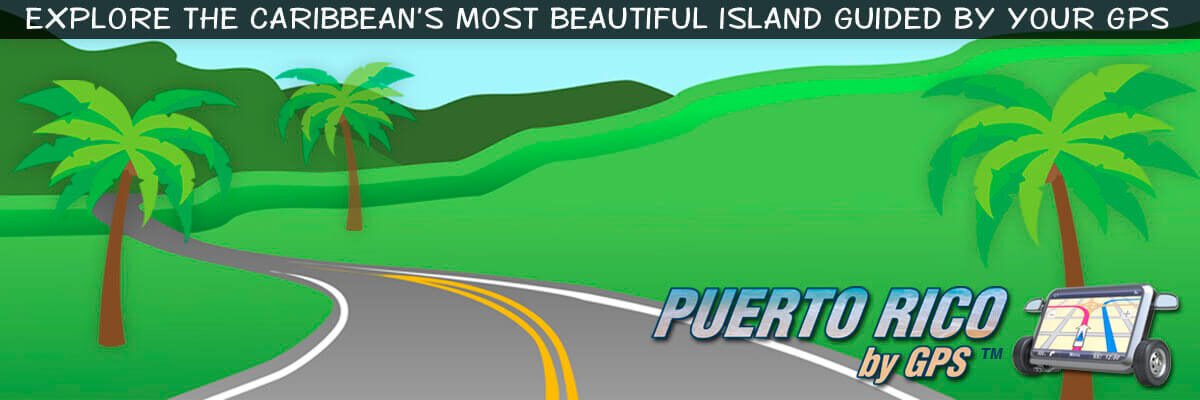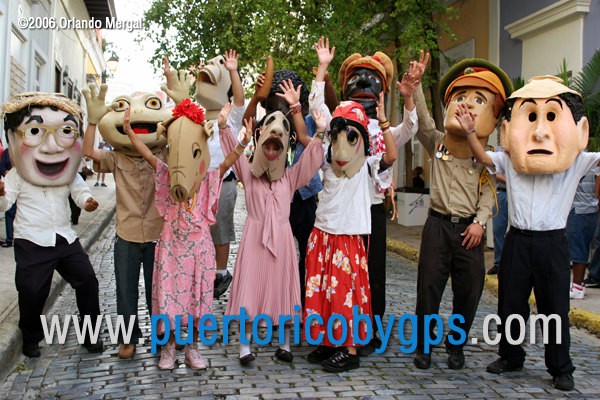
I shot this image on January 20, 2006 without realizing that I was capturing all the original “cabezudos” except one. From left to right: Don Cholito, El Coquí, La Puerca, Juan Bobo, Maximina La Loca, Toribio, la Jíbara, Diplo, El General and Maso Rivera. Alfonsa Villamonte Vera “La Billetera” died in 2008 and her cabezudo was made later.
The 2014 edition of the San Sebastian Street Fiestas is about to start. Next Thursday, January 16, 2013, mayor Carmen Yulín Cruz will be cutting the traditional ribbon and the 44th edition of the world’s largest event, taking place during the month of January, will commence.
I could write for hours about the San Sebastian Street Fiestas. I could tell you about the artisan fairs, the music at most of the old city’s squares, the artists that line San Sebastian Street, the fact that it all started with a religious event, and even about the SanSe 2014 contraction, that has become so popular among the citizenry, but is totally disfavored by the event organizers. But all of that has been said before and it’s all over the Internet.
Instead I’m going to write about the faces of the San Sebastian Street Fiestas. After all, every major event in the world has them. At the “San Fermines” it’s all about the bulls. At “la Tomatina” it’s all… well, about throwing tomatoes. At Río it’s all about gorgeous women and costumes. At Mardi Gras it’s all about food and music. And at the San Sebastian Street Fiestas the centerpiece are the Cabezudos.
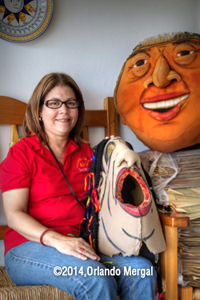
Carmen Julia Díaz with her favorite “cabezudo” masks: “Maximina La Loca” and “La Billetera”.
Just go to the “pictures” section in Google and write “Fiestas de la Calle San Sebastian” and you’ll see the Cabezudos in almost every picture. They are —without a doubt— the face of the San Sebastian Street Fiestas.
This morning I spent a couple of hours talking with Mrs. Carmen Julia Díaz, a member of the organizing committee who is in charge of los Cabezudos. And while I’ve been attending the “fiestas” for over 20 years, I have to admit that I learned a lot.
Carmen Julia is a retired math teacher born in the municipality of Fajardo, about 30 miles east of San Juan. She has been a part of the organizing committee for over 17 years and this year she is proud to be in charge of los Cabezudos.
The original San Sebastian Street Fiestas started in 1954 as a fund raising event, created by father Juan Manuel Madrazo. Eventually they went into a hiatus until the mid 1970’s when Rafaela Balladares de Brito, a former teacher, rescued them —once again as a fundraiser— for the “Colegio de Párvulos” (elementary school) located at the eastern end of San Sebastian Street.
Carmen Julia met Balladares at a “Discovery of Puerto Rico” celebration. “She was the guest of honor and our principal chose me to be in charge of the event”, said Carmen Julia. The two women immediately discovered that they had multiple interests in common. They were both teachers, they were both artisans and they were both profoundly in love with Puerto Rico. So they became friends for life.
“Balladares was the creative mind that gave birth to the Cabezudos”, said Carmen Julia. She was also a stern woman who led the festivities with a watchful eye almost ’til the time of her death in the month of September, 2011. She was 97.
When father Madrazo started the original fiestas there were only two figures in the entire parade. They represented the king and queen of Spain and they were the kind that you see in Spain; effigies at the end of a long pole.
But Balladares wanted something truly Puerto Rican, so she came up with the idea of creating large masks resembling popular figures from Old San Juan. Hence the word “cabezudos” (people with big heads).
The first cabezudo was “el general” (the general). “El general” was an actual “sanjuanero” (Old San Juan resident) who used to dress up in military clothing, medals and all, and directed traffic at one of the city’s intersections.
Then came “Diplo” and “Toribio”. Diplo’s full name was Ramón Rivero. He was a comedian, actor, composer and a pioneer in Puerto Rico’s radio, television and cinema industries.
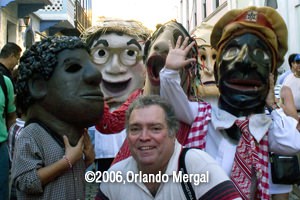
My wife insisted and I posed.
Toribio’s full name was Patricio Rijos Morales. He was a humble black man that never learned to read or write. But he had one special talent. He was called “el rey del güícharo”. A “güícharo” (pronounced gweecharo) is the Puerto Rican name for a guiro, which is a Latin-American percussion instrument consisting of an open-ended, hollow gourd with parallel notches cut in one side. It is played by rubbing a stick or tines along the notches to produce a ratchet-like sound. And Toribio was truly the best player that Puerto Rico has ever had.
Pretty soon Balladares realized that she would run out of popular San Juan residents so she widened her scope to include figures from all walks of Puerto Rican folklore.
The first cabezudo in this second tier was “Maximina La Loca”, a lady from the neighboring town of Loíza who loved to dance and wore dozens of small bowties in her hair. In case you’re wondering, “Maximina La Loca” means Maximina the crazy one.
Then she looked at Puerto Rican literature and created the cabezudos for “Juan Bobo”, “La Puerca” and “La Jíbara”. “Juan Bobo” is the most beloved folkloric character on the island of Puerto Rico. (learn more on Wikipedia). “La Puerca” was actually a character in one of the “Juan Bobo” books and “La Jíbara” represents the rural woman of the 19th century.
After that Balladares looked at Puerto Rican nature. And what could be more Puerto Rican than the “Eleutherodactylus Portorricense” or “coquí”, small little frog that is native to Puerto Rico and produces a peculiar sound that resembles its name. You can listen to an actual “coquí” on the player below.
The last three cabezudos were “Don Cholito”, Maso Rivera” and “La Billetera”. “Don Cholito’s” real name was José Miguel Agrelot and he was one of the greatest and most beloved comedians in Puerto Rican history.
Maso Rivera’s full name was Tomás Rivera Morales. He was a Puerto Rican musician (cuatro player) and a major exponent of Puerto Rico’s Jibaro (folkloric) music. Rivera composed over 1,000 instrumental compositions for the Cuatro, Puerto Rico’s national instrument.
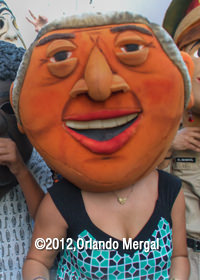
La Billetera
Finally, “la billetera” was Alfonsa Villamonte Vera, a resident of Old San Juan who sold lottery tickets at one of the city’s street corners. After her death, her relatives approached the organizing committee to ask if they would create a cabezudo in here memory.
So what are the cabezudos? They’re actually children —for the most part— who lead a comparsa, several times a day, dancing down San Sebastian Street from one end to the other. Behind them you’ll see thousands of party-loving Puerto Ricans who sing and dance to the tunes of a group of “pleneros”.
Plena is one of three music styles that originated in Puerto Rico. The other two are Bomba and Danza. Bomba and Plena are folkloric in nature, whereas danza is of a formal nature.
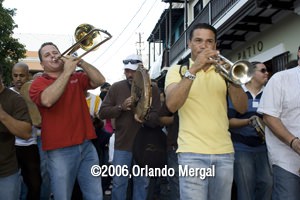
Pleneros
Plena is played on a series of hand drums called “pleneras” and often includes trombones and trumpets.
The word “comparsa” comes from Cuba and it refers to a group of percussionists —usually playing congas— accompanied by brass instruments and singers that perform at carnivals.
Actually, the organizing committee in charge of the San Sebastian Street Fiestas doesn’t refer to the comparsa as “the comparsa”. They call it a desfile (parade). But the people —without a doubt— refer to it as “la comparsa”.
Finally, the cabezudos are the lifeblood of the San Sebastian Street Fiestas. Without them we’d be left with a large group of artisans and thousands of people drinking beer. They are truly the life of the party.
Enjoy Puerto Rico,
©2014,Orlando Mergal, MA
____________________
Bilingual Content Creator, Blogger, Podcaster,
Author, Photographer and New Media Expert
Tel. 787–750-0000, Mobile 787–306-1590
